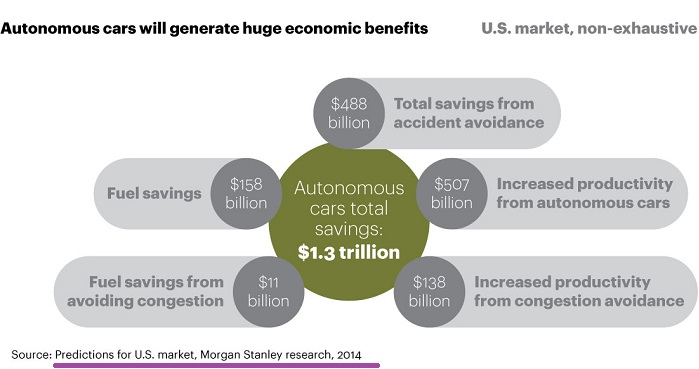Related Categories
Related Articles
Articles
Autonomous Driving
(Status: year 2017)
The societal benefits of autonomous driving; Imagine a world with fewer accidents, fewer traffic deaths, greater energy efficiency, and lower insurance premiums. This is the world of autonomous driving. It brings mobility to people who lack easy...

...or practical access to driving, such as the elderly and disabled. It also appeals to the lifestyles and virtues embraced by millennials, such as health, entertainment, and mindfulness. The estimated annual savings for the United States alone is expected to be around USD 1.3 trillion, as shown in the figure above.
By the later stages of innovation, ATKearney, in accordance with the industry experts who participated in their interviews, expect the following benefits to be especially powerful:
♦ Reduce traffic accidents by 70 percent, saving thousands of lives every year
♦ Lower vehicle service costs by 35 percent, in part because self-driving cars have far fewer mechanical wear-and-tear parts
♦ Cut energy consumption by 30 percent, not only because of alternative energy sources but also because automobiles can use car-to-car communications to swarm or travel in convoys (platoon driving), thus improving efficiency and traffic flow
♦ Reduce insurance liability by more than 15 percent as driving becomes much safer and new insurance models emerge
An interesting "vision" taken from the report:
Some observers believe connected mobility will create a new form of dependency, as people grow accustomed to satisfying their needs and communication desires from within their self-driving vehicles. If this is true, then first-mover advantage goes to the first company that bundles information density, content access, and mobility into a single compelling package. If one of these companies really does claim 10 to 15 percent of the automotive market, it will be an important and influential player, not (only) a niche company!
A sneak into the Market-potential for the upcoming decade:
The biggest leap over the next decade will be the integration of mobile broadband systems with robotic drive systems. Companies or alliances of companies that first develop a standard will be the winners, and their reward will be revenue and double-digit EBIT growth.
The apparent quantum leap in both technology and revenue from the "current years onwards" to 2035 will not be a single leap but a steady and rapid progression through a series of generations (see following figure).

The transition to fully autonomous will also be gradual and steady. It will follow a technology roadmap that includes mobile broadband systems, vehicle radar and location systems, and automation or robotic drive technologies using big data infrastructure management such as augmented reality. Tapping into this vast potential will require unprecedented levels of collaboration and cooperation among OEMs, telecommunications firms, media and Internet companies, and government bodies.



